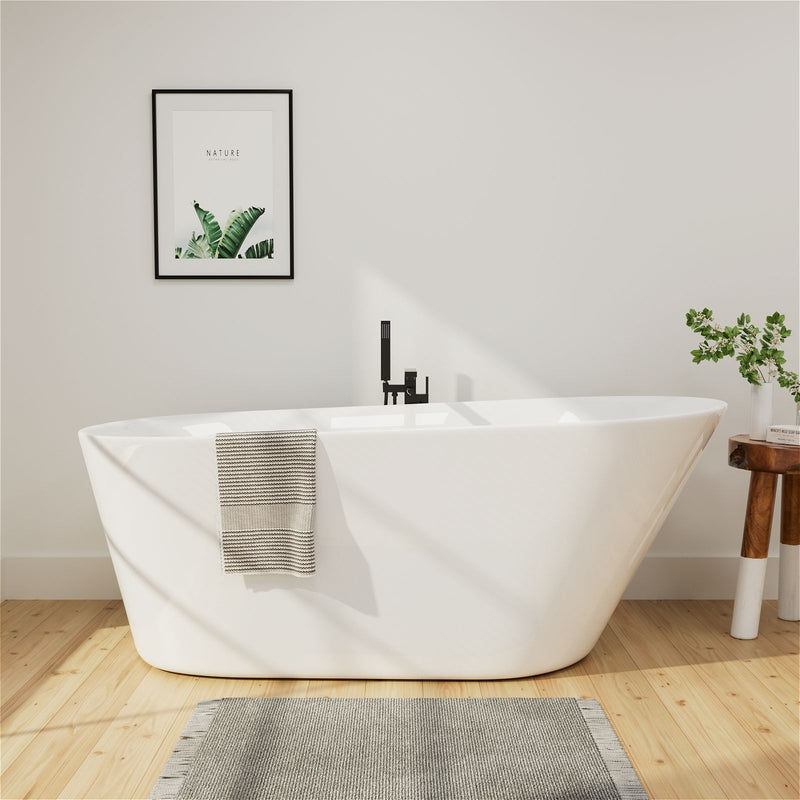More than any other bathroom fixture, a bathtub spout may be more susceptible to staining and corrosion from hard water. Fortunately, this is one of the easiest bathroom problems to fix. You only need to replace the spout, and you can do it yourself even if you have limited plumbing skills. You just need to know how to use a wrench and/or a screwdriver.
When Should You Replace a Bathtub Spout?
Situations that require replacing a bathtub spout include the following:
Water Flow Problems
Unstable water flow: If the water flow from your bathtub faucet feels erratic or uneven, there may be a problem with a component inside the bathtub spout that needs to be replaced.
Temperature Regulation Problems
Temperature cannot be regulated properly: When the water temperature cannot be regulated, or the water temperature is not as expected, the mixing valve and other components may be faulty and need to be replaced.
Leakage Problems
Bottom leaks: If there are signs of leakage at the bottom of the bathtub faucet, there may be a damaged seal or other component that needs to be replaced to prevent water damage and damage to the bathroom structure.
Worn or Damaged Appearance
Aging: If your bathtub faucet has worn, oxidized, or rusted surfaces, replacing it can improve the appearance of your bathroom and ensure smooth operation of the fixture.
Changing Bathroom Decor
Remodeling needs: When doing a total bathroom remodel, replacing your bathtub spout can be part of your efforts to improve the look, style, and functionality of your bathroom.
Functional Updates
Need new features: If you want to add new features to your bathroom, such as water-saving fixtures, waterfall effects, or other modern features, replacing your faucet is an effective way to achieve these goals.
Types of Bathtub Spouts
Spouts come in two types: slip-on and screw-on.
Slip-on Spouts
Slip-on bathtub spouts have a set screw, which is a small screw located at the bottom of the bathtub spout. Slip-on bathtub spouts are designed to slide into 1/2-inch copper pipes without the use of any threads. When using this type of spout, the end of the copper pipe must be free of burrs or rough edges.
Threaded Spouts
Threaded bathtub spouts have no set screws and can be unscrewed from the fitting or pipe. There are two styles: a front-threaded tub spout or a rear-threaded tub spout.
A front-threaded tub spout can be used with a tub valve without a shower or with a tub valve that has a shower diverter built into it.
A wall spout (also called a "rear threaded" spout) is more convenient to use because it can be connected to the short pipe fitting (1/2-inch or 3/4-inch) of the wall-mounted tub spout via a bushing. A rear threaded spout can be used in new construction or retrofit. There are a variety of models available, such as a traditional diverter close to the wall or with a dedicated spout attachment to facilitate the use of a hand shower or free-standing tub (for exposed showers).
A telescoping spout is also a threaded tub spout that can be adjusted to the wall size, usually up to 1 inch (about 2.5 cm), providing flexibility for a variety of installation applications. The telescoping spout can be connected to a 1/2-inch or 3/4-inch (about 0.9 cm) threaded fitting via a bushing.
How to Remove a Tub Spout
Tools Needed to Remove a Tub Spout
- Caulking Gun
- Files
- Flashlight
- Hen Wrench
- Internal Pipe Wrench
- Phillips Screwdriver
- Rags
- Slide-Lock Pliers
- Tape Measure
- Tube Cutter
- Utility Knife
Materials Needed to Remove a Tub Spout
- New Spout
- Silicone Caulk
- Thread Sealing Tape
- Threaded Fittings
How to Remove a Slip-On Tub Spout
Step 1: Remove any caulk around the wall end of the tub spout with a putty knife or razor.
Step 2: Locate the set screw, which is usually located at the bottom of the spout, close to the wall. They are usually small, so using a flashlight may help.
Step 3: Determine what tool you need to remove the screw; most will require a hex wrench/Allen key, while some will require a small Phillips or flat-blade screwdriver. Loosen the screw, being careful not to drop it down the drain.
Tip: Place a towel over the tub drain before loosening the set screw to prevent it from falling down the drain.
Step 4: After loosening the retaining screws, use both hands to pull the tub spout straight out and away from the wall. If the spout has been in the wall for a while, it may be a little stuck. If so, you can try to twist the spout slightly as you pull.
Tip: Make sure the retaining screws are completely loosened before turning the spout. If the retaining screws remain tight on the pipe while you turn the spout, you may damage the pipe coming out of the wall. If the retaining screws are very difficult to turn, you can insert a screwdriver or wrench into the opening of the tub spout and use leverage to loosen it by twisting the spout. However, try not to wiggle the spout and pipe, as excessive wiggling may cause problems with the pipe in the wall.
How to Install a Slip-On Tub Spout
Step 1: Check that the pipe coming out of the wall is the correct size. For a slip-on tub spout, the copper pipe should be at least 1 inch (2.5 cm) long and up to 2-7/8 inches (6.75 cm) long, depending on the tub spout. Before purchasing and installing, refer to the manufacturer's specifications to make sure the spout is the right length. If your pipe is shorter than the minimum length, you may need an adapter to fit the new spout. If the pipe is shorter than the minimum length, you may need to cut the pipe slightly.
Step 2: If the pipe is sticking out of the wall, clean any buildup on the pipe. If there are burrs or rough areas on the end of the pipe, use sandpaper to smooth it out.
Tip: For copper pipe running through fiberglass or thin-walled pipe, use stainless steel push-lock nuts to secure and lock the copper pipe. You can find these stainless steel push-lock nuts on our page.
Step 3: Slide the tub spout into the pipe until it fits against the wall. Then tighten the set screw to secure the spout.
How to Remove a Threaded Tub Spout
Remove the spout with a large pipe wrench. Hold the wrench on the tub spout and turn it counterclockwise to loosen it. Removing a threaded tub spout is really as easy as unscrewing it!
How to Install a Threaded Tub Spout
Step 1: Make sure the new spout is the same length as the old one to avoid having to adjust the pipe or use adapters.
If you have a front-end threaded spout, measure from the wall to the end of the spout to get the right size.
If you have a WALL-END threaded spout, the maximum length of the nipple should be 1/2 inch.
If you have a telescoping threaded spout, the maximum length of the nipple should be 1-3/8 inches.
Step 2: Apply about 4-6 turns of PTFE thread sealant tape.
Step 3: Apply some silicone caulk to the edge of the pipe where it meets the wall to prevent water from dripping from behind the spout into the shower wall.
Step 4: Screw the nozzle onto the pipe, screwing slowly so that the threads don't cross. Tighten until secure, and make sure the nozzle is aligned vertically with the rest of the fixture.
FAQs on How to Remove a Tub Spout
Q: What tools do I need to remove the tub spout without the set screws?
A: A pair of adjustable pliers or a pipe wrench will suffice. Wrap the spout with a cloth to avoid scratching the surface, then hold the spout firmly and twist it counterclockwise.
Q: What if the tub spout still won't come off after twisting it counterclockwise?
A: If the spout is stubborn, you can apply penetrating oil around the base and let it sit for a while. This will help loosen any corrosion. Applying heat with a hair dryer may also help. Be patient and try twisting it again.
Q: How can I prevent damage to the wall when removing the tub spout?
A: To protect the wall, you can place a piece of cardboard or a rag between the wall and the wrench or pliers. This will help distribute the pressure and prevent damage to the wall surface.
Q: Can I use WD-40 or another lubricant to remove the tub spout?
A: Yes, a lubricant like WD-40 can help loosen a stuck tub spout. Apply it around the base and let it sit for a while before trying to twist the spout again.
Q: What should I do if the pipe starts to twist with the tub spout?
A: If the entire pipe is turning, it may be connected to a threaded fitting in the wall. Use pliers to hold the pipe steady while you turn the spout to prevent damage or leaks.
Q: Can a disassembled bathtub spout be reused?
A: Yes, if the spout is in good condition, it can usually be reinstalled. Clean the threads and inspect the spout for damage before reinstalling.
Q: Is it common for a bathtub spout to be difficult to remove?
A: This is common, especially for spouts that have been installed for a long time. Corrosion and mineral deposits can make it difficult to unscrew. Being patient and using a lubricant or penetrating oil may help.
Q: Should I contact a professional plumber if I have difficulty?
A: If you are unsure or have major difficulties, it is recommended that you consult a professional plumber. They have the expertise and tools to handle complex situations and ensure a correct installation.





